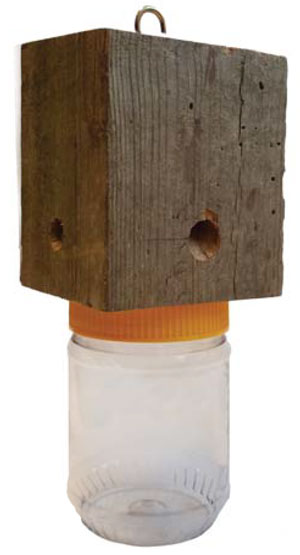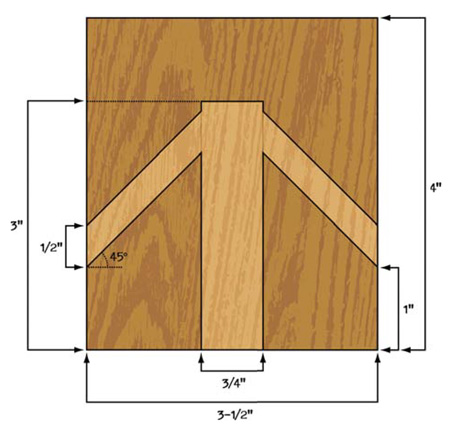Contact
Apiculture Instructor
Phone: 501-671-2222
Fax: 501-671-2252
Email: jzawislak@uada.edu
Web: uaex.uada.edu/bees
University of Arkansas System Division of Agriculture
Cooperative Extension Service
2301 S. University Avenue
Little Rock, AR 72204
Carpenter Bee Control in Arkansas
Carpenter bees or “wood bees” are named so because they nest inside holes in dead wood. If they are unable to find a nesting cavity, female carpenter bees will excavate a long, round tunnel in which to rear their young. There are many small carpenter bee species in the United States, which prefer to nest in pithy plant stems, but the large eastern carpenter bee Xylocopa virginica is the only species typically noticed by homeowners, and is considered a pest due to the damage caused by their nesting.
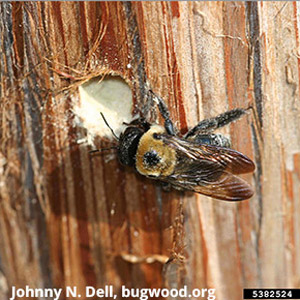
Female carpenter bee boring a gallery. She does not eat the wood, but provisions the tunnel with food to rear her off spring.
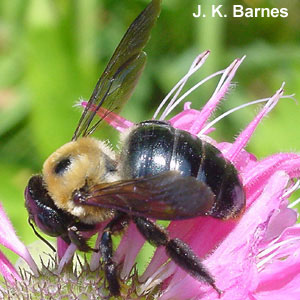
Carpenter bees have shiny, hairless abdomens, unlike furry, striped bumble bees.
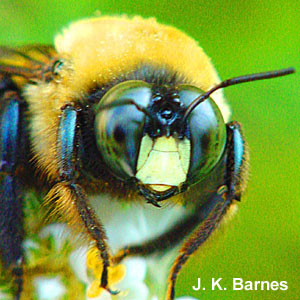
Male carpenter bees have a white patch on their faces. Males can be territorial, but are unable to sting.
How can I identify a carpenter bee?
Carpenter bees are large (up to 1” long) and heavy-bodied, with a smooth, hairless abdomen. They closely resemble bumble bees in size and color, but the abdomen of a bumble bee is covered in dense hair, often with distinctive striped patterns. Male carpenter bees have an obvious white patch in the middle of their faces, which is lacking in females. Female bees also have thick tufts of hair on their hind legs, used for transporting pollen back to their nests.
Biology and Behavior
Young adult bees overwinter by hibernating in nesting galleries excavated from solid wood, and emerging in the spring to mate. Long periods of extremely cold weather may kill some overwintering bees. Survivors usually begin to emerge in mid-spring, and seek floral nectar as food. During this time they are most active and noticeable by homeowners.
Male carpenter bees emerge first, and may be seen hovering around nesting sites or patches of flowering plants, awaiting the emergence of females. Males can be highly territorial, and may hover or buzz erratically around humans. While the presence of these large bees can be intimidating, the males cannot sting, and are harmless to people.
Female carpenter bees can deliver a painful sting, but rarely do so unless provoked. After mating, male bees soon die, and fertilized females will begin to prepare a nesting site. After nests have been established, female bees are mainly observed loitering near their nest entrance or foraging in nearby flowers.
Carpenter bees do not eat the wood they excavate, but create these tunnels for rearing
young. The female bee provisions her tunnel nest with “bee bread” (a mixture of pollen
and nectar collected from flowers), which serves as food for the larvae when the eggs
hatch. She constructs a separate cell for each egg, which she closes off with a thin
wall of chewed wood pulp. There may be as many as six to eight cells in each tunnel.
The time required to complete development from egg to adult varies from 1 to 3 months.
Though newly matured adults usually emerge in late August, these bees will not mate
to start the cycle over again until the following spring.
What kind of damage can carpenter bees do?
Carpenter bees can be destructive pests, as they bore into seasoned woods, especially soft woods such as cedar, redwood, pine, and fir. Damage may occur to soft or weathered wood on porches, decks, sheds, barn beams, railings, overhead trim, porch furniture, dead tree limbs, fence posts, wooden shingles, wood siding, windowsills, wood doors, etc.
Female bees bore circular holes, about 1/2-inch wide, into the wood at right angles to the surface for about an inch, then turning sharply, boring in the direction of the wood grain for 4 to 6 inches or more. They may clean out and reuse old tunnels, lengthen existing tunnels, or sometimes create a new branch inside an existing tunnel, with a single entrance being used by multiple females. If a female is unable to locate a suitable nesting tunnel, she will bore an entirely new gallery. Damage caused by a single bee is slight, and mainly aesthetic. However, existing tunnels may be used again and lengthened by other broods, and the bee population may increases over successive seasons. The combined activity of numerous bees over a period of years can cause some structural weakening.
How do I prevent them?
Painted wood is rarely attacked by carpenter bees, so keep all exposed wood surfaces well painted. Wood stains will not prevent attacks. Wood pressure treated with a preservative should be used if painting is not practical. Treatment involves applying an insecticide into the tunnel entrance. Treat the opening after dark, when bees are less active (female bees may reactive defensively if nesting activities are disturbed).
Apply an insecticidal dust or liquid spray into each hole, and to the wood surface several inches around the entrance.
Find specific control products Household and Structural Pest Control
Do not plug the holes immediately, but allow returning bees to pass freely so they can contact the insecticide and spread it through the nest. Dust formulations work best, and will not dry out or soak into wood. After a day or two, insert a small ball of steel wool into the tunnel, then fill the hole with carpenter’s putty or a wooden dowel to prevent further use. The steel wool will prevent any trapped bees from being able to quickly chew their way out, and they will soon succumb to the insecticide. If nests are numerous or out of convenient reach, limited control can be affected by treating the wood around the entrance with a suitable residual insecticide labeled for structural use (consult MP144 for current recommendations).
Individuals who use pesticides are responsible for ensuring that the intended use complies with current regulations and conforms to the product label. Before purchasing or using any pesticide, always read and carefully follow the label directions. For assistance, contact your local County Cooperative Extension Office.
What's the best way to trap carpenter bees?
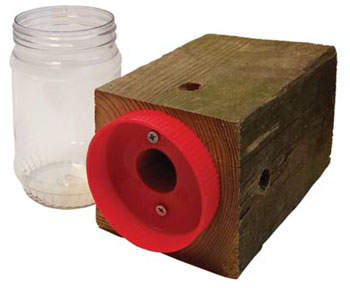
Traps will eliminate female bees searching for new nesting sites in the spring, helping to reduce local populations and preventing additional damage.
Effective traps can be easily constructed from scrap wood, and few dimensions are critical. The basic plan shown here uses a section of 4x4 post. Untreated, unpainted wood will be the most attractive to the bees.
Drill 1/2” diameter holes in the sides, tilting upward at about a 45o angle, which meet the larger hole drilled upward through the center of the block. Drill or punch a large hole in the lid of a suitably sized jar, and attach it to the bottom of the block as shown. Make holes on all four sides if the trap will be hung in the open, or on three sides if the trap will mounted against a wall. The top of the block can be cut at a slight angle to shed water if the trap will be placed in an area exposed to weather.
Hang traps wherever carpenter bees are observed looking for nesting sites in the spring.
Females will enter the
small holes to investigate a potential new nesting site, and will then be attracted
down to the jar by the light. Their compound eyes will not see the clear jar, and
they are unlikely to find their way back out through the hole they entered. Simply
unscrew the jar to empty out dead bees.
Creating alternative habitat for carpenter bees
Though considered a pest by many, carpenter bees are beneficial pollinators of many native plants, including tomatoes, blueberries and melons. While adults feed on nectar for energy, these bees do not produce honey, but they are highly efficient at pollen collection and transport.
Homeowners may choose to provide them with acceptable alternative nesting sites away from susceptible structures. Place a small bundle of softwood (4” diameter, 18-24” long) in a sunny location adjacent to a garden, protected from rain. Bees can be encouraged to take up residence in these logs by drilling 1/2” diameter holes in the end grain of the wood. Keep this bundle dry and above the soil to prevent damage from termites or fungal rot.
